Explore the world of drums and percussions with this comprehensive overview. Discover the different types and find the perfect one for your musical needs.
Drums and percussion instruments are an essential part of any musical ensemble. They come in a wide range of sizes and shapes and can be found in various styles of music, from classical and orchestral to contemporary and rock.
Whether you are a drummer or just someone who loves music, understanding the different types of drums and percussions is crucial for appreciating the immense variety of sounds these instruments can produce.
In this blog post, we will cover different types of drums, what a drum set actually is, types of hand drums, drums around the world, and much more. Let’s dive in without further ado.
Drums (An Overview)
Drums are one of the oldest and most versatile instruments in the world. They can be found in every culture, from ancient tribal communities to modern music studios. There are many different types of drums, each with its own unique sound and purpose.
One of the most common types of drums is the drum set. A drum set, also known as a drum kit, usually consists of a bass drum, snare drum, tom-toms, and cymbals. The bass drum provides the low-end thump, while the snare drum adds a sharp, crackling sound. Tom-toms are used for fills and accents, and cymbals provide a smooth, shimmering sound.
Hand drums are another popular type of drum. Hand drums are played by hitting the drumhead with your hand instead of a drumstick. Some popular types of hand drums include the djembe, conga, and bongo. Each of these drums has a unique sound and is used for different styles of music.
Drums can also be found in many different cultures around the world. For example, the taiko drum is a traditional Japanese drum that is often used in festivals and ceremonies. The tabla is a traditional Indian drum that is used in classical and folk music. The dhol is a double-headed drum originating in India and is commonly used in bhangra music.
Overall, drums are a versatile and important instrument in the world of music. Whether you are playing a drum set or a hand drum, there is something special about the sound and rhythm that they create.
What are the Different Types of Drums?
Drums can be broadly classified into three main categories – acoustic drums, electronic drums, and hand drums. Each of these categories has its own unique qualities that make them suitable for different types of music and playing styles.
Acoustic Drum
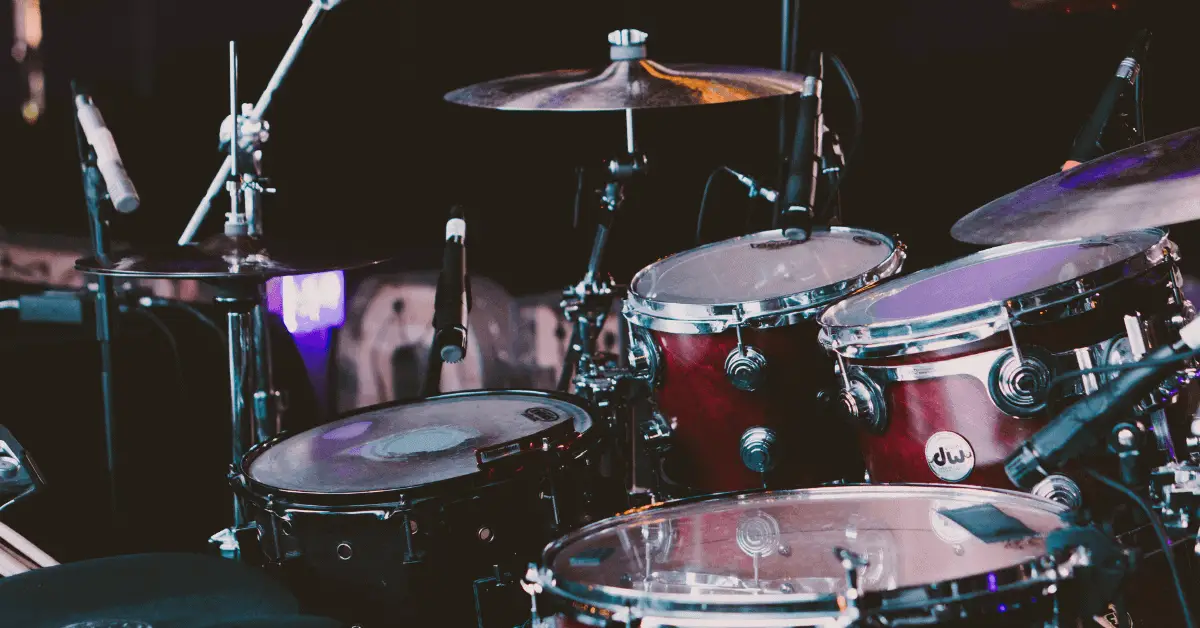
An acoustic drum is a type of drum that produces sound when hit with a drumstick or mallet. They come in many different sizes, from smaller drums like the snare drum to larger drums such as the bass drum. They are typically made of wood and have a drumhead stretched across the top of the drum. This drumhead, made of either plastic or animal skin, is tightened or loosened to produce a range of sound pitches and qualities.
Acoustic drums are further characterized by their separate components, which include the bass drum, snare drum, tom-toms, and cymbals. Each drum serves a unique purpose in a drum set and contributes to the overall rhythm and beat of the music. The bass drum, also known as the kick drum, is the largest and lowest-pitched drum in a set. It is played with a foot pedal and provides the foundation for the rhythm.
The snare drum is smaller compared to the bass drum and features metal “snares” or wires stretched against the bottom drumhead, producing a sharp, crisp sound when struck. Snare drums often help to maintain time in a music piece and are used for accents and syncopation.
Tom-toms are cylindrical drums that can be mounted, hung, or stood on legs. These drums come in different sizes, and each size yields a different pitch. Toms are primarily used for fills and solos, adding tonal variety to the rhythm. Cymbals, although not technically drums, form an essential part of an acoustic drum set. They are made of metal and generate a wide array of sounds depending on their size, shape, and the material they are made from.
The most common cymbals included in a drum set are the hi-hats, crash cymbals, and the ride cymbal. Each cymbal has its unique function in creating rhythm, accents, and a palette of sounds. Acoustic drums are favored by many drummers for their natural, warm, and full sound. They are also chosen for their dynamic range and feel, allowing a drummer to achieve a diverse and authentic expression when playing.
However, acoustic drums can be challenging in terms of their weight, size, and volume, particularly in certain settings like small venues or apartments.
Electronic Drum
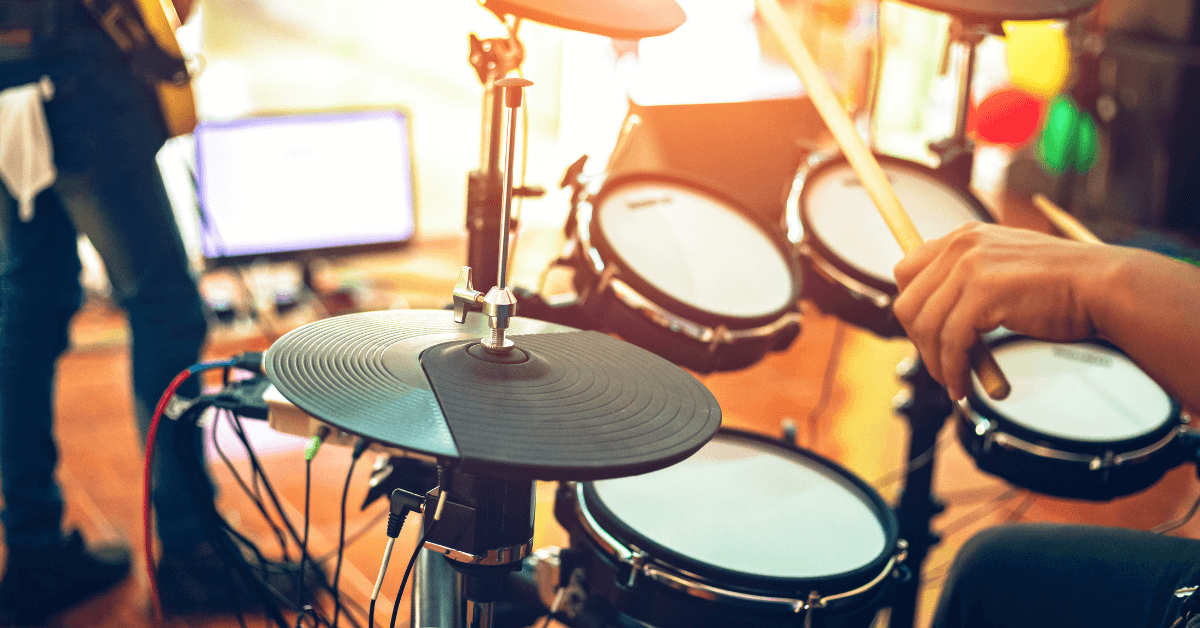
Electronic drums, as the name suggests, use electronic sensors to trigger sound instead of traditional drumheads. They offer a more compact and versatile option for drummers who require a more modern sound. They often come equipped with drum pads, which can be programmed to sound like various types of drums and percussions.
Electronic drum pads are essentially rubber or mesh surfaces that, when struck by drumsticks, trigger a digital sample or synthesized sound to be played. These pads are designed to emulate the feel and responsiveness of the surfaces of acoustic drums and cymbals. They have built-in sensors to detect the intensity and location of the strike, providing a more dynamic and expressive playing experience. One of the primary advantages of electronic drum pads is their programmability.
Drummers can choose from a wide range of drum and percussion sounds, including classic acoustic drum set sounds, electronic and synthesized drum sounds, as well as world percussion instruments like congas, bongos, and tabla. This allows drummers to experiment with various genres of music and create custom drum kits tailored to their specific preferences and requirements.
Additionally, electronic drum pads often come with built-in effects and sound processing capabilities, such as reverb, delay, and equalization. This not only allows drummers to shape their sound but also enables them to utilize creative effects not traditionally possible on acoustic drums.
Electronic drum pads can be used in both practice and performance settings. The ability to adjust the volume or wear headphones provides a quiet and convenient practice alternative for drummers, making them an ideal practice solution for a variety of environments, especially urban and shared spaces.
With electronic drum pads being MIDI compatible, they can serve as a powerful tool for composing and recording music. Drummers can easily connect the drum pads to a computer, digital audio workstation, or electronic instrument to record their performance or trigger other sounds in real time.
Overall, electronic drum pads offer versatility, customization, and convenience that traditional acoustic drums cannot provide. They have become a popular choice for beginners and professional drummers alike due to their adaptability and modern advancements in technology.
Hand Drums
Hand drums are played by striking the drumhead with bare hands or using mallets. They are often used in world music, such as African, Indian, and Latin music, and can range from small drums such as the frame drum to larger drums such as the conga drum. Some common types of hand drums include:
- Djembe: Originating from West Africa, this goblet-shaped drum produces a wide range of tones and is played with bare hands. The body is typically carved from hardwood and features a goatskin drumhead.
- Frame Drum: These are shallow, flat drums with a diameter larger than its depth. Frame drums are present in many cultures, including Irish, Arabic, and Indian music. They can be played with hands or sticks and produce low-pitched, resonant tones.
- Conga: A popular drum in Afro-Cuban music, the conga is a tall, barrel-shaped drum played with the palms, fingers, and heel of the hand. The drum is held between the player’s knees or on a stand.
- Bongo: This Cuban instrument consists of two small, attached drums, one larger (hembra) and one smaller (macho). Bongos are usually played by placing them between the thighs, and the player strikes the drumheads with their fingers and palms.
- Tabla: A pair of hand drums used in Indian classical music, the tabla consists of a smaller, high-pitched drum called the dayan, and a larger, low-pitched drum called the bayan. The drums are played with the palms and fingers utilizing complex finger techniques.
- Doumbek: Also known as the darbuka, this goblet-shaped drum is popular in Middle Eastern and North African music. The drum is held under the arm or between the legs, and the drumhead is struck with the hands and fingers.
- Cajón: This box-shaped drum comes from Afro-Peruvian culture and is made of wood. Players sit on the cajón and strike the front panel with their hands or fingers, producing a variety of timbres.
- Bodhrán: A traditional Irish frame drum played with a double-headed wooden stick called a tipper. The drum is held vertically or placed on the player’s knee, and the back of the drumhead is dampened with the non-dominant hand to alter the pitch and tone.
- Tambourine: A small frame drum with pairs of jingles called zills attached to the frame. The tambourine can be struck with the hand or shaken to produce a rhythmic sound. It is a common instrument in many music genres, including classical, pop, rock, and folk music.
- Talking Drum: A talking drum is a type of hourglass-shaped drum that is played by squeezing and releasing the strings that run alongside the drumhead. They are commonly used in West African music and for storytelling.
- Goblet Drum: A goblet drum, also known as a doumbek, is a small drum that has a goblet-shaped body and a drumhead stretched across the top. It is played with the hands and produces a sharp, crisp sound.
These are just a few examples of hand drums found in world music, each with its unique characteristics and cultural significance. We will talk more about some of the above drums in more depth in the later sections of this article. Let’s keep going!
What is a Drum Set or a Drum Kit?
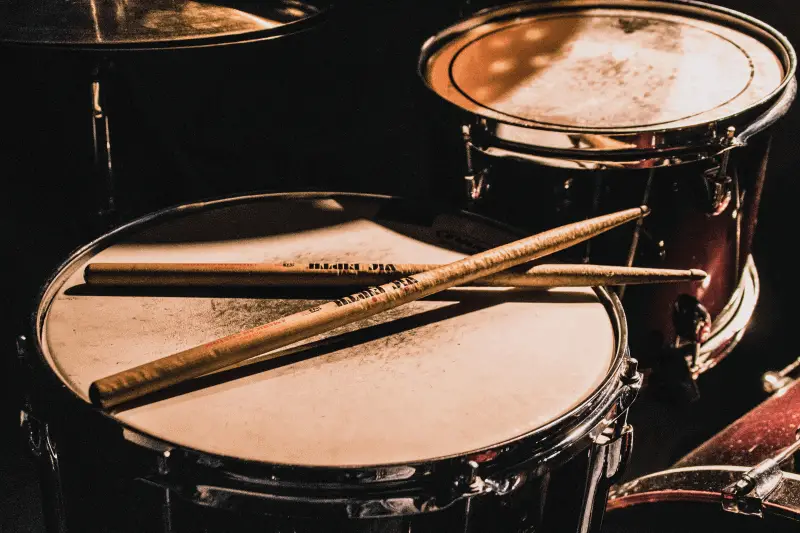
A drum set, also known as a drum kit, is a collection of drums and cymbals that are played simultaneously by a drummer. It typically includes a bass drum, snare drum, and a set of cymbals, such as the hi-hat, crash cymbal, and ride cymbal. The drummer sits behind the drum set and plays each instrument with drumsticks or mallets.
Bass Drum
The bass drum, also known as the kick drum, is usually the largest drum in the drum set. It produces a deep, low-pitched sound when hit with a mallet or pedal. It provides the rhythmic foundation for many types of music.
Snare Drum
The snare drum is a smaller drum that produces a sharp cracking sound. It is usually positioned to the drummer’s left and is played with drumsticks. It is commonly used to provide the backbeat in rock, funk, and jazz music.
Cymbals
Cymbals are percussion instruments that produce a shimmering, crashing sound when struck with a drumstick or mallet. They come in many different sizes and pitches and are essential for creating dynamic sounds in any style of music.
What are Some Types of Marching Drums?
Marching drums are a type of drums that are used in marching bands, parades, and other similar events. They are designed to be lightweight and portable and can be carried by the drummer while marching. Some of the most popular types of marching drums include:
Tenor Drum
A tenor drum is a small drum that is held horizontally and played with two sticks. It is commonly used in marching bands and drum corps to provide a rhythmic pulse. Tenor drums come in various sizes and configurations, with the most common version being the “quad” or “quint” – consisting of four or five drums mounted on a single carrier, allowing the drummer to play multiple pitches.
They are designed to be lightweight and portable, making them ideal for marching performances. The heads of tenor drums can be made from either synthetic materials or calfskin, providing different tonal qualities. The drums are played using a combination of strokes, rolls, and rimshots, which can produce a wide range of rhythmic patterns and accents.
These are often used to complement the melodies and harmonies played by the brass and woodwind sections in a marching band. In addition to marching bands and drum corps, tenor drums are also used in various styles of music, such as military, pipe band, and fusion genres. They may also be combined with other percussion instruments, such as snare drums and cymbals, to create a complete percussion set-up for a wide variety of performances.
Tenor drummers frequently use visual tricks and stick flips to add excitement to their playing, and marching band arrangements often incorporate complex tenor drum parts that require high levels of skill, dexterity, and coordination. Like other members of marching bands, tenor drummers must also possess strong marching and drill techniques to stay in formation and maintain precise timing throughout their performances.
Bass Drum
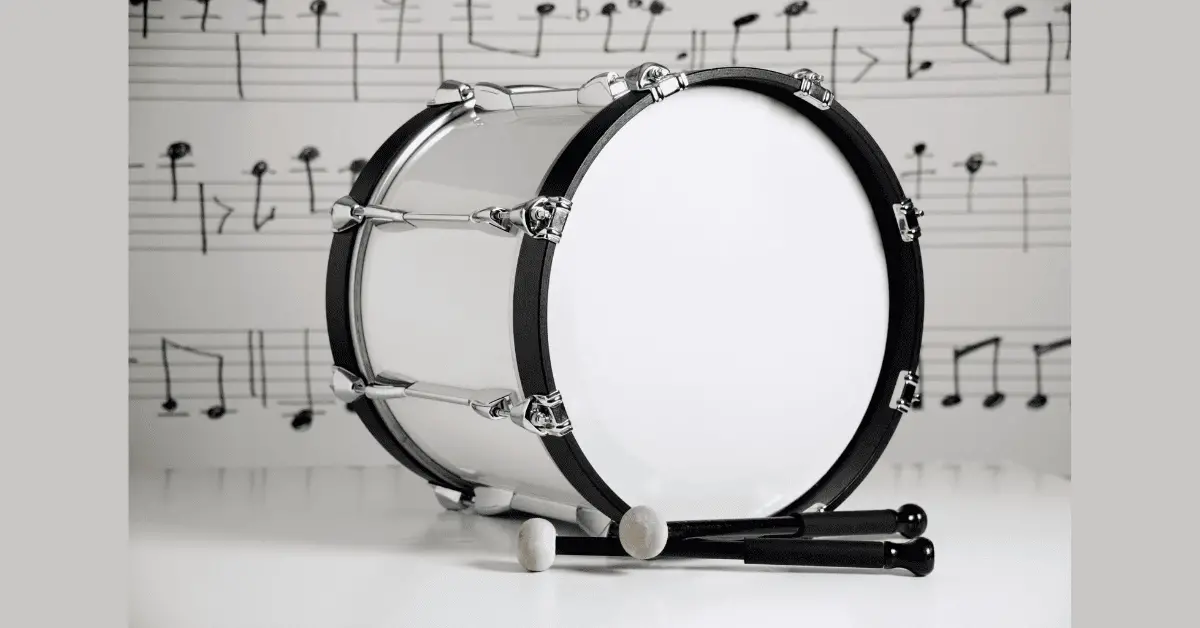
The bass drum is the largest and most powerful drum in the marching band. It provides the rhythmic foundation for the entire ensemble and is played using a special pedal. The bass drum is usually mounted on a harness and played by a single drummer who stands or marches while striking it with one or two mallets. In some marching bands, there may be multiple bass drummers, each playing a different size drum to create a more diverse tonality and rhythm.
The size of a bass drum can range from 16 inches to 32 inches in diameter, with larger drums producing lower, more resonant tones. The shell of the drum is typically made from wood, such as maple, birch, or mahogany, and the drumheads are made from synthetic materials like Mylar or Kevlar.
One of the primary functions of the bass drum in a marching band is to keep a steady beat and pulse for the ensemble. This helps the band stay synchronized and maintain a consistent tempo while marching and playing their instruments.
Additionally, the bass drum can also be used to add emphasis and power to the music, as well as complement and enhance the rhythms played by the other percussion instruments in the band. In order to play the bass drum effectively, the drummer must have a strong sense of timing and rhythm, good technique, and excellent coordination.
Using the correct mallet grip, proper striking technique, and controlled wrist and arm movements are essential for achieving a precise and powerful sound. Additionally, the bass drummer must be able to march in step with the rest of the band while maintaining complete control over their instrument.
Overall, the bass drum plays a crucial role in a marching band by providing the rhythmic foundation that supports and drives the rest of the ensemble. Its size and power make it a commanding presence on the field, often creating a strong impact on the music and contributing to the excitement and energy of a marching band performance.
Marching Snare
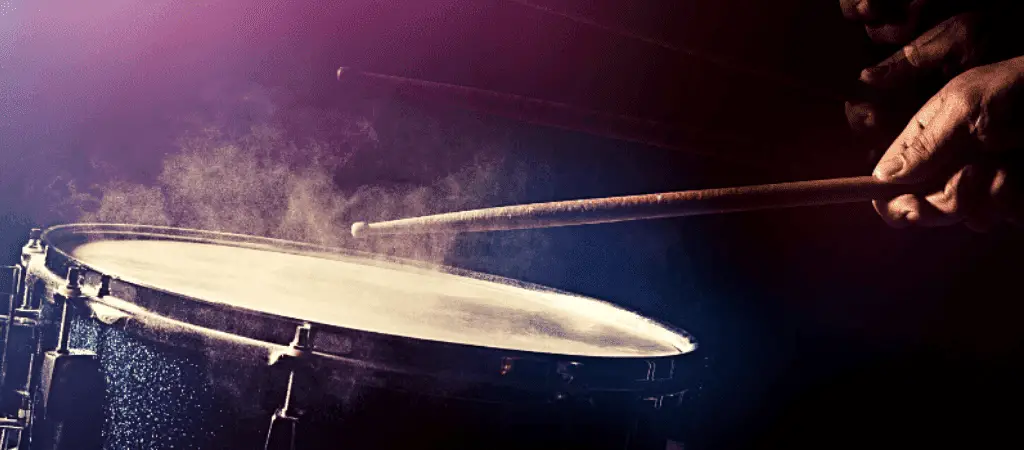
The marching snare is a type of snare drum that is associated with marching bands and drum corps. It is designed to be lightweight and portable and is played with two sticks. Additionally, marching snares are constructed with a higher tension for increased projection and a crisp, articulate sound that can cut through the ensemble in outdoor settings.
The drum’s design usually consists of a metal or wooden shell, two drumheads (top and bottom), and a set of adjustable snares stretched across the bottom drumhead. Marching snares are worn by the player using a carrier or harness, which allows them to maintain proper posture and technique while marching and playing.
The drum may also be used in a stationary setting, like in concert band or percussion ensemble performances, by placing it on a snare drum stand. Drummers in a marching band or drum corps are typically required to perform intricate and challenging rhythmic patterns while maintaining perfect synchronization with the rest of the ensemble.
This level of precision demands a high degree of skill, practice, and dedication. Furthermore, the visual aspect of the marching band and drum corps performances often includes elaborate choreography and drill formations, meaning that drummers need to be able to play while moving in various formations and maintaining their position relative to the rest of the ensemble.
In summary, the marching snare is specifically designed for marching ensembles, allowing percussionists to perform complex rhythmic patterns with powerful projection and precise articulation while being able to march and execute visual formations.
What are Some Drums from Around the World?
Drums have been an integral part of music around the world for centuries. From Africa to India and the Caribbean, here are some of the most well-known drums from around the world:
African Drums
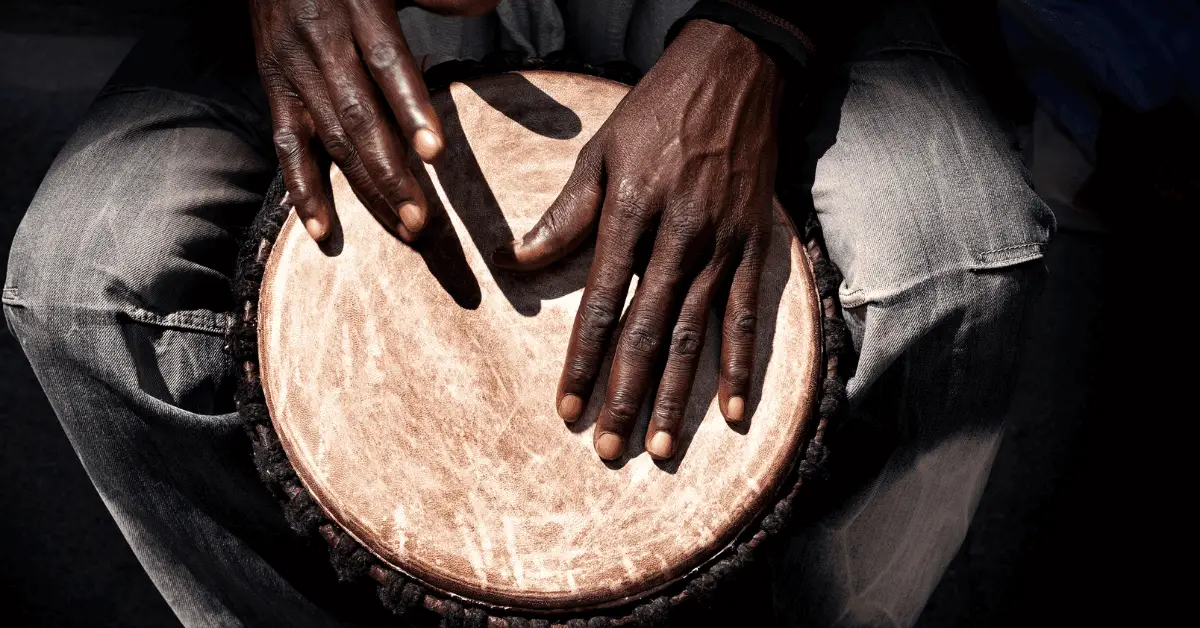
African drums come in different sizes and shapes and are made from a variety of materials. They are typically played by hand and are an essential part of many African musical traditions. Some of the most popular types of African drums include:
- Djembe: This is probably the most famous African drum. It originates from West Africa and has a goblet shape. It is carved from hardwood and has a goat or synthetic skinhead. Djembe drums are played using hands and produce a wide range of sounds, including deep bass tones and sharp slaps.
- Bougarabou: Also from West Africa, this drum is similar in shape to the djembe but with a long cylindrical body. It is often made from hardwood and has cow skin or synthetic skin as the head. Bougarabou drums are played by hand and produce deep, rich bass tones.
- Talking drum (Dundun and Tama): These are hourglass-shaped drums that are played with a mallet or curved stick. They have a unique method of producing sound – the player squeezes the drum under his arm, which tightens or loosens the strings on the drum, changing the pitch. Talking drums are used to communicate messages over long distances and are also an integral part of African ceremonies and storytelling.
- Kpanlogo: A Ghanaian drum known for its versatility, the Kpanlogo has a conical shape and is made from softwood or hardwood. Its head is made of goat or antelope skin, and it can be played either with hands or sticks, producing a range of sounds. Kpanlogo is associated with the recreational music and dance of the Ga people of Ghana.
- Bata: This is a family of double-headed drums originating from Nigeria’s Yoruba people. The different sizes are Iya (the largest), Itotele (medium), and Okonkolo (the smallest), and they are played with hands or sticks. Bata drums are traditionally used in religious ceremonies and rituals.
- Conga: Although more commonly associated with Cuban music, conga drums have roots in African drumming traditions. They are barrel-shaped drums made from wood or fiberglass and have a stretched animal or synthetic skinhead. Conga drums are played with hands and often come in pairs or sets of three.
- Udu: This is a unique African clay drum originating from Nigeria’s Igbo people. It is shaped like a water jug and has a hole on top and one on the side. Udu drums are played by tapping, slapping, or drumming fingers on the surface, producing a range of deep and high-pitched sounds.
- Tabla: These are small drums typically made of wood, metal, or ceramics, often played during traditional African ceremonies and celebrations. They produce a high-pitched sound and are played with hands or sticks.
There are numerous other African drums, each with its unique features and importance in the cultural and musical diversity of the continent. African drums are not only essential instruments in traditional African music but have also influenced and enriched music genres worldwide.
Indian Drums
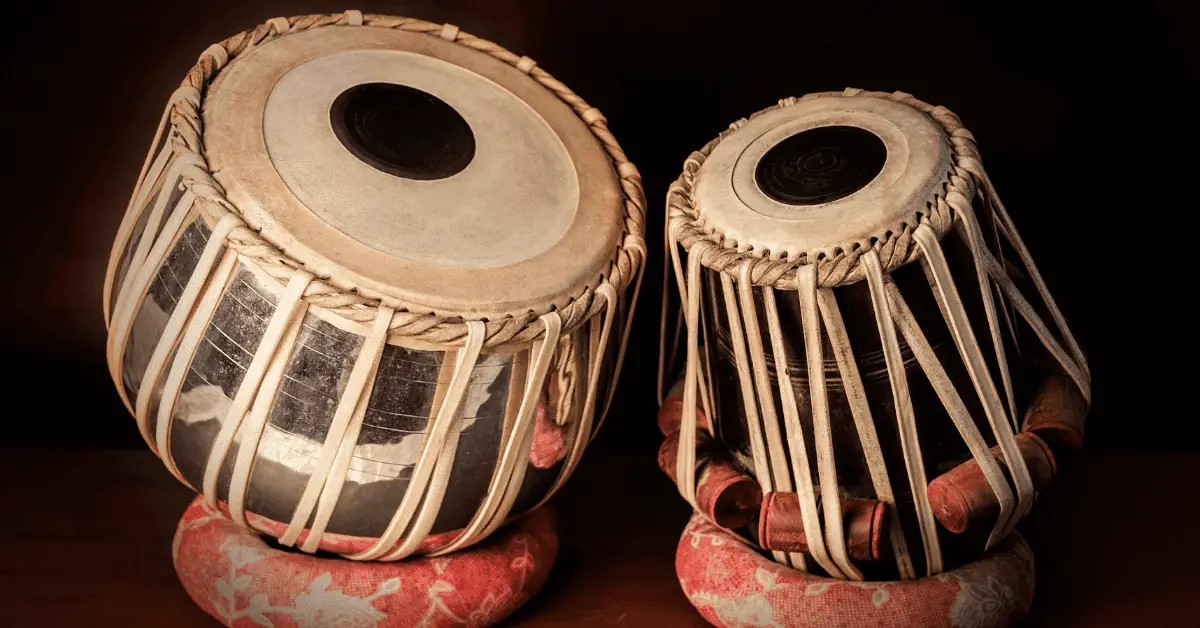
Indian drums, such as the tabla and mridangam, are hand drums that are typically played in Indian classical music. They are played by striking the drumheads with their fingers and palms. Indian drums have a long history, with some dating back to ancient times. These drums play a crucial role in Indian classical music, and many have specific techniques and rhythms associated with them.
The two most popular Indian percussion instruments are the tabla and the mridangam. The tabla is arguably the most well-known Indian drum outside of India. It consists of two drums, typically made of wood or metal, and features layered drumheads made from animal hide or synthetic materials. Tabla drumheads have a black spot at their center called the ‘syahi,’ made of iron oxide and rice paste, which gives the drums their unique tone.
The two drums that make up the tabla are the ‘bayan’ (larger, lower-pitched left-hand drum), and the ‘dayan’ (smaller, higher-pitched right-hand drum). Tabla players sit cross-legged on the floor with their left hand playing the bayan and their right hand playing the Dayan.
The mridangam is a double-sided barrel-shaped drum used primarily in South Indian classical music. It is made from a hollowed-out log, traditionally jackfruit wood, with drumheads on both ends. The drumheads are usually made from goatskin, with a similar black spot (syahi) in the center. The right side of the mridangam has a higher pitch, while the left side has a bass resonance.
Mridangam players sit cross-legged on the floor, holding the instrument across their laps with their right hand playing the smaller head and their left hand playing the larger head. Indian drums are played using a combination of finger and palm techniques, which vary between tabla and mridangam.
Tabla players use precise fingerings to create a wide range of sounds, along with different hand placements for accents and softer tones. Mridangam players also use fingerings and palm techniques but may incorporate more open-handed strikes and full-hand slaps to achieve a variety of sounds and rhythms.
The rhythms played on Indian drums can be incredibly intricate, utilizing traditional rhythmic cycles called ‘talas.’ These cycles define the structure of a piece of music and can have varying lengths and subdivisions. Indian percussionists often engage in complex rhythmic interplay with other musicians and must have a deep understanding of the talas and the underlying rhythmic structure of a piece in order to perform accurately and expressively.
In addition to their use in classical music, Indian drums have also influenced modern popular music, world music, and other folk traditions outside of India. In many cases, Indian drummers collaborate with musicians from different musical backgrounds or perform solos, showcasing their unique skills and bringing the captivating sounds of Indian percussion to a wider audience.
Steel Drums
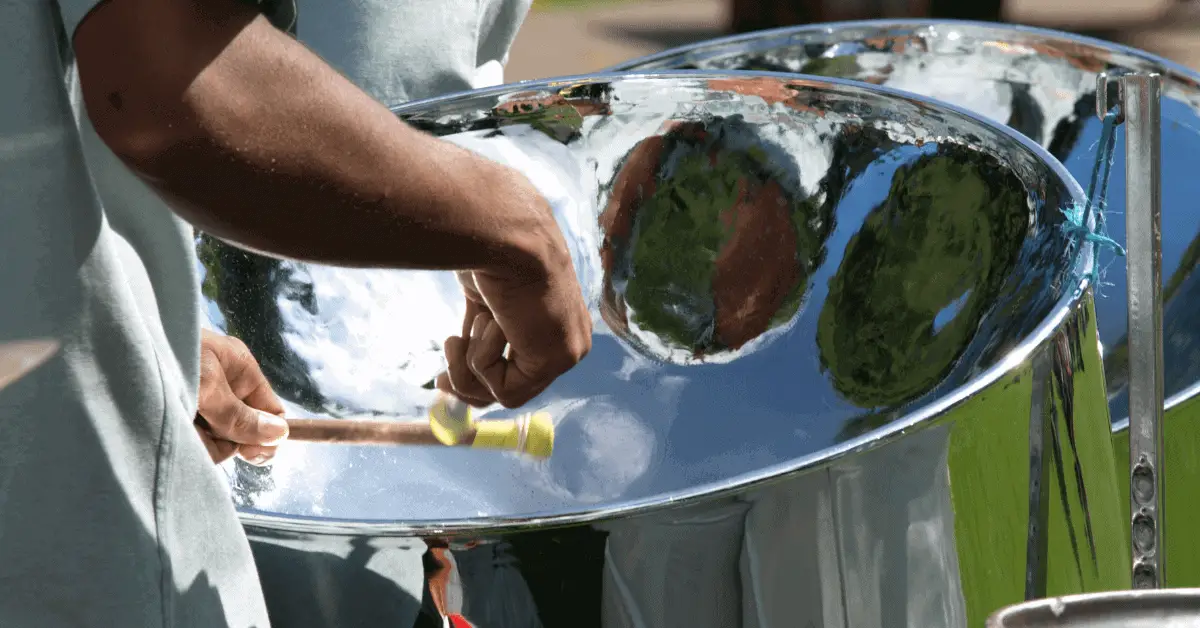
Steel drums, also known as pans, are a type of percussive instrument that originated in the Caribbean islands of Trinidad and Tobago. They are made by hammering convex-inverted steel pans into a concave shape and are typically played using drumsticks.
Steel drums, also known as steel pans or simply pans, are unique musical instruments originating from Trinidad and Tobago. They are made from steel oil drums, which are hammered into a concave shape to create different pitches and sounds. The playing surface of a steel pan is divided into several sections, each corresponding to a different note.
To make a steel drum, a 55-gallon oil drum is first cut to the desired height. The metal is then heated to soften it and make it more malleable. The top part of the drum called the skirt, is where the notes are hammered into the concave shape. The steps to create the pan’s face are as follows:
- Sinking – The surface of the drum is hammered into a concave shape.
- Grooving – A pattern with a note layout is traced onto the sunken surface, and grooves are drawn dividing the different notes.
- Shaping and cutting – Each note section is hammered into its approximate shape, and the metal is cut around the notes so that they are more distinct.
- Tuning – The metal is hammered further to fine-tune and refine each note’s pitch to ensure accurate and pleasing tones.
- Finishing – The final touches include smoothing rough edges and adding a finish to the surface of the pan. Once the steel drum is complete, it is played using specialized drumsticks, typically made of wood and tipped with rubber.
Each note on the drum produces a distinct pitch when struck, and skilled musicians can create intricate melodies and harmonies by striking different sections of the pan in succession. Steel pan ensembles, often called steel orchestras or steel bands, can range from small groups with just a few musicians to large orchestras with up to 100 or more performers. They play a wide range of musical genres, including Calypso, Soca, Reggae, Jazz, and even Classical music.
Frequently Asked Questions – Types of Drums and Percussions
Q. What is a percussion instrument?
A percussion instrument is a type of musical instrument that is played by striking, shaking, or scraping. They can produce a variety of sounds and rhythms and are an essential component in many different types of music.
Q. What are the different types of drums?
Drums come in many shapes and sizes and can be classified in a variety of different ways. Some of the most common types of drums include bass drums, snare drums, hand drums, marching drums, and electronic drums.
Q. What is a drum kit?
A drum kit is a collection of drums and cymbals that are played by a single drummer. A typical drum kit consists of a bass drum, snare drum, tom-toms, hi-hat, ride cymbal, and crash cymbals, among other components.
Q. What are cymbals?
Cymbals are a type of percussion instrument that consists of a thin, circular metal plate that produces a ringing sound when struck. They are commonly used in a variety of musical genres, including rock, jazz, and orchestral music.
Q. What is an acoustic drum?
An acoustic drum is a type of drum that produces sound through the vibration of a drumhead made of animal skin or synthetic material. They are often used in a live performance setting and can produce a wide range of different sounds and tones.
Q. What is a frame drum?
A frame drum is a type of hand drum that consists of a circular frame with a drumhead attached to it. They are often played with the hand and are commonly used in Middle Eastern and Celtic music.
Q. What is a talking drum?
A talking drum is a type of hourglass-shaped drum that is played by squeezing and releasing the drumhead under one arm while striking it with a curved stick held in the other hand. They are commonly used in West African music.
Q. What is a tenor drum?
The tenor drum is a type of marching drum.
Final Words
Drums and percussions come in many different sizes, shapes, and pitches, and are used in various styles of music. They offer musicians and drummers countless ways to express themselves and create different sounds that enhance the music. Whether you are playing in a marching band or a major concert, the world of drums and percussion is full of possibilities.
